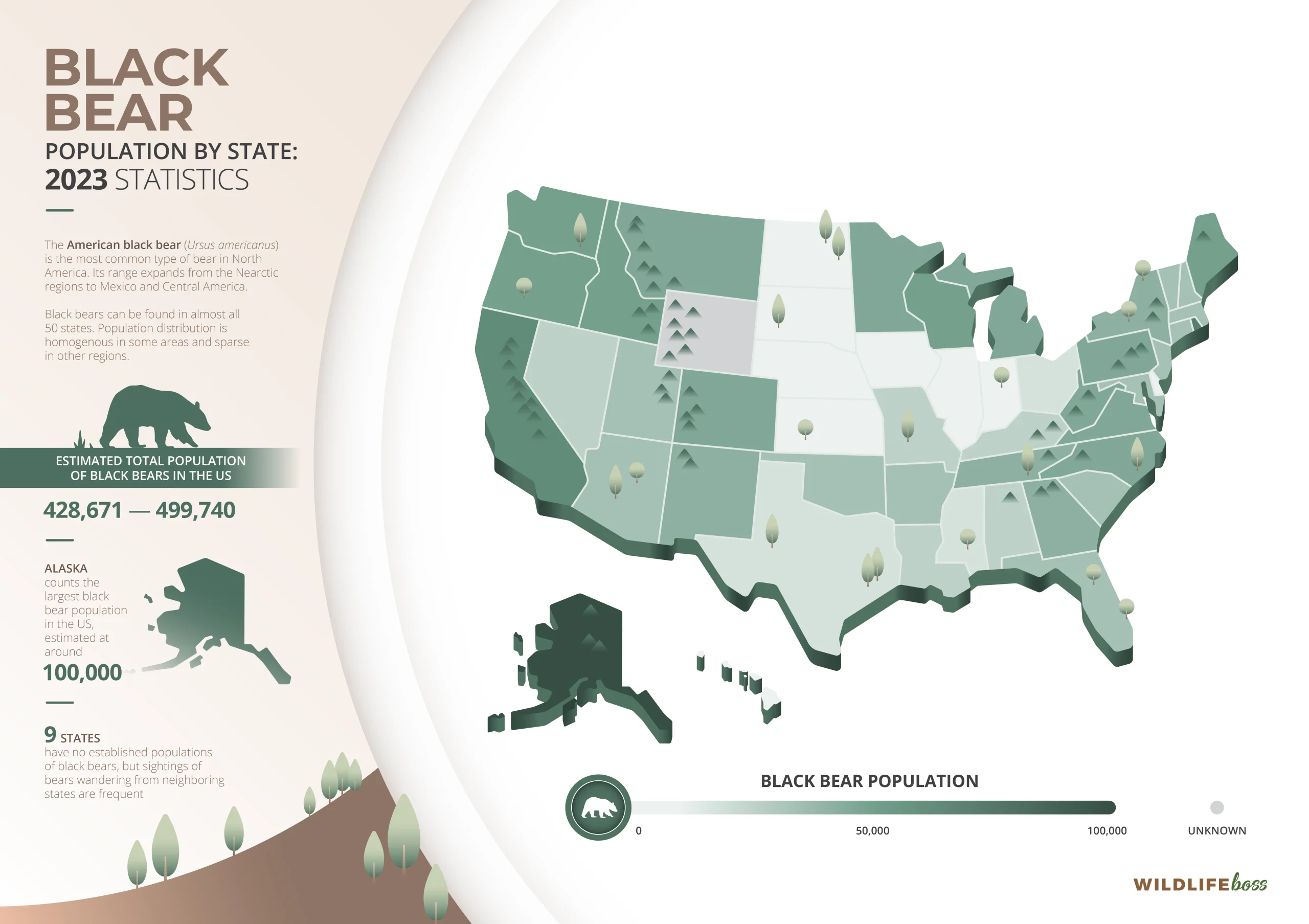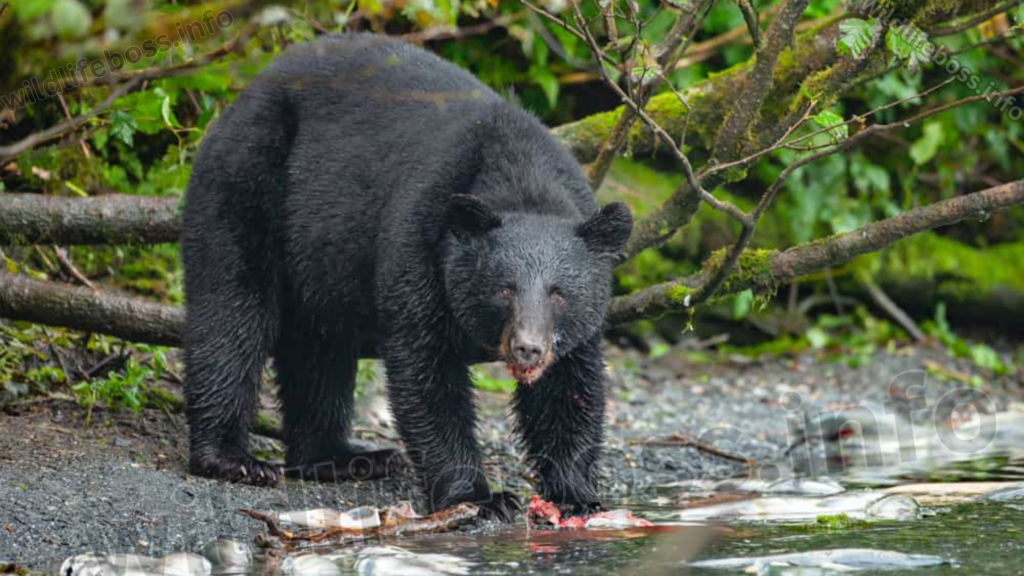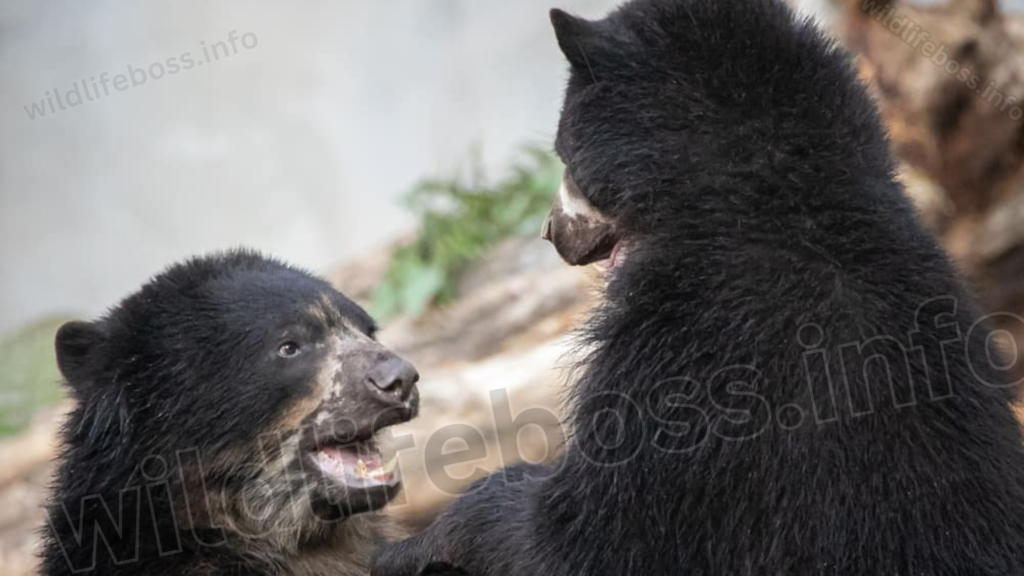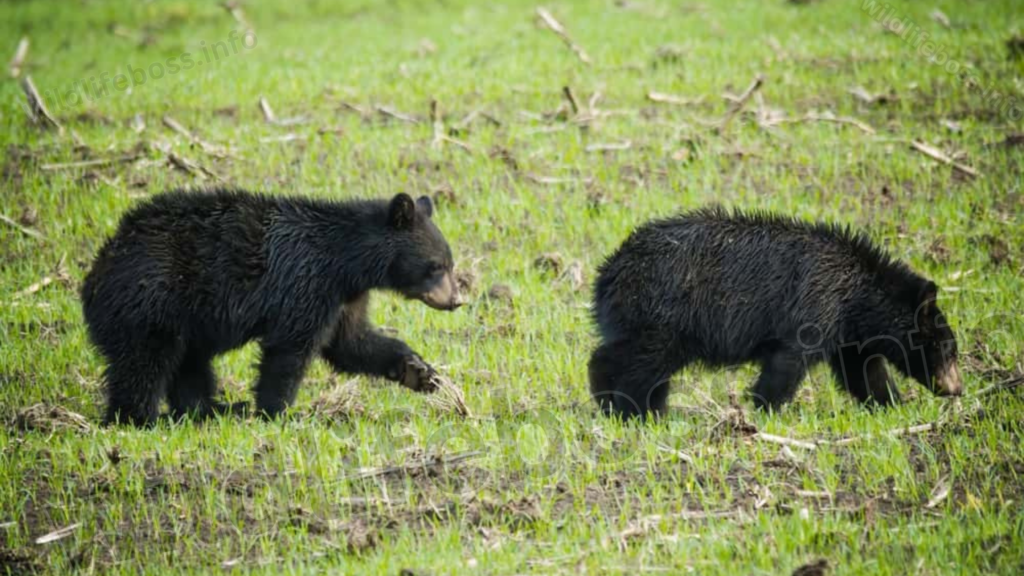In North America, the American black bears (Ursus americanus) is the most prevalent bear species. Its range extends to Mexico and Central America from the Nearctic areas.
Black bears can be found in almost every state in the United States. In certain places, the population distribution is uniform, whereas in other places, it is scarce.
Here are the most recent data and trends on the black bear population by state, whether you’re wondering how many black bears exist in your state or how likely it is that you’ll see one while hiking.
Key Facts
- There are an estimated 428,671 to 499,740 black bears in the United States. Wyoming’s population size is unclear, hence these figures do not include that state.
- There are an estimated 100,000 black bears in Alaska, which has the biggest population in the United States.
- Despite the fact that nine states lack established black bear populations, bears are frequently spotted straying from other states.
- Though certain jurisdictions may have particular laws, most states allow the harvesting of black bears.

The estimated number of black bears in each state* is displayed in the table below:
| Jurisdiction | Black Bear Population* | Bear Sighting Frequency** |
|---|---|---|
| Alabama | 300 – 400 | Rare |
| Alaska | 100,000 | Common |
| Arizona | 2,500 – 3,500 | Common |
| Arkansas | 3,000 – 4,000 | Common |
| California | 30,000 – 40,000 | Common |
| Colorado | 17,000 – 20,000 | Common |
| Connecticut | 1,000 – 1,200 | Serious |
| Delaware | 0 (None) | Rare |
| Florida | 4,050 | Common |
| Georgia | 5,100 | Common |
| Hawaii | 0 (None) | No sightings |
| Idaho | 20,000 – 30,000 | Common |
| Illinois | 0 (None) | Rare |
| Indiana | 0 (None) | Very rare |
| Iowa | 0 (None) | Rare |
| Kansas | 0 (None) | Rare |
| Kentucky | 500 – 1,000 | Common |
| Louisiana | 750 – 1,000 | Rare |
| Maine | 24,000 – 36,000 | Common |
| Maryland | 2,000 – 2,250 | Serious |
| Massachusetts | 4,500 – 5,000 | Rare |
| Michigan | 12,000 | Rare |
| Minnesota | 12,000 – 15,000 | Common |
| Mississippi | 40 – 50 | Very rare |
| Missouri | 540 – 840 | Rare |
| Montana | 13,000 – 17,000 | Common |
| Nebraska | 0 (None) | Very rare |
| Nevada | 500 – 600 | Common |
| New Hampshire | 4,800 – 5,000 | Rare |
| New Jersey | 3,000 | Rare |
| New Mexico | 8,000 – 9,000 | Serious |
| New York | 6,000 – 8,000 | Common |
| North Carolina | 15,000 – 20,000 | Common |
| North Dakota | 0 (None) | Rare |
| Ohio | 50 – 100 | Common |
| Oklahoma | 2,500 | Common |
| Oregon | 25,000 – 30,000 | Common |
| Pennsylvania | 18,000 | Common |
| Rhode Island | 5 – 10 | Serious |
| South Carolina | 1,000 – 1,600 | Common |
| South Dakota | 0 (None) | Common |
| Tennessee | 6,000 | Common |
| Texas | 36 – 40 | Rare |
| Utah | 4,000 | Common |
| Vermont | 3,500 – 5,500 | Common |
| Virginia | 18,000 – 20,000 | Common |
| Washington | 25,000 – 30,000 | Common |
| West Virginia | 12,000 – 14,000 | Common |
| Wisconsin | 24,000 | Common |
| Wyoming | Unknown | Common |
The Wildlife Department reports, scientific publications, news sources, and other official sources referenced throughout this article were the origins of all figures in the table. The information is accurate as of January 2024 and should only be used as a guide. Data on the black bear population is subject to change and may be updated at any moment by the appropriate authorities.
The amount of sighting reports that government agencies and other authorities get from citizens and visitors in each state determines the frequency of sighting reports. They should only be used as a guide and are not a measure of population density.
Sea also: Wild Hog Population By States 2024 Statistics
Black Bear Population Trends By State

Alabama
- Estimated population size: 300 to 400
- Hunting permitted: No
According to history, black bears are indigenous to the whole state of Alabama. Although over-harvest and habitat destruction reduced their numbers to almost extinction, things have improved in recent years.
According to current estimates, there are between 300 and 400 adult black bears in Alabama.
Although there aren’t many, sightings could happen anywhere in the state. There have been 14 sightings confirmed between April and September of 2022 alone.
14 sightings have occurred between April and September of 2022.
Alaska
- Estimated population size: 100,000
- Hunting permitted: Yes. Draw permits, harvest tickets, hunting licenses, or registration tickets are needed.
- Hunting season: Year-round
Alaska, the USA’s northernmost state, boasts the biggest black bear population. There are an estimated 100,000 bears in the state.
During the warmer months, usually April or May through September, sightings are fairly common. The state’s frigid environment resulted in a lengthy denning season, typically spanning from October to April. Nevertheless, interactions with black bears are possible on milder days throughout the year because they are not real hibernators.
In Alaska, black bears may be harvested. In most counties, the hunting season is open all year long. Black bears can live side by side with grizzlies and polar bears in some areas of Alaska.
Arizona
-
- Estimated population size: 2,500 to 3,500
- Hunting permitted: Yes. You must have a valid hunting license and a black bear tag.
- Hunting season: Summer/Fall, Winter
Because of Arizona’s year-round hunting seasons and lax harvest regulations, black bears—the only bear species still living there—were on the verge of extinction.
After 1954, stricter regulations were put in place, which improved population trends.
According to surveys and harvest trends, the current adult population number ranges from 2,500 to 3,500 animals. The northern and eastern regions of Arizona are home to the majority of Arizona’s black bears.
Arkansas
-
- Estimated population size: 3,000 to 4,000
- Hunting permitted: Yes. A current hunting license and a black bear tag are necessary.
- Hunting season: Fall, Winter
The present population of black bears in Arkansas is thought to be between 3,000 and 4,000 individuals, however it is challenging to count wildlife in forested areas.
Experts also think that these numbers are rising based on trends and regular observations.
Arkansas permits the fall and winter harvesting of black bears, whose numbers are thought to be steady. Zone-by-zone variations may exist in the actual dates of the season.
California
- Estimated population size: 30,000 to 40,000
- Hunting permitted: Yes. It is important to have a bear tag plus have a hunting license.
- Hunting season: Summer, Fall
Surprisingly, therefore, California is host to America’s second largest black bear population even despite its geographical contiguity with other states. It is estimated that the population is about 30, 000 to 40, 000 peop in the entire population.
A big proportion of black bear dwell in the Sierra Nevada area of the northern portion of the state. There are two other populations which occur widely in the counties of Riverside and Monterey in the Los Padres National Forest.
There is no statewide distinction between a hunting season and a deer season, they are the same thing. In the current licensing year, and as a rule, there can be only one adult bear shot per bag.
Colorado
- Estimated population size: 17,000 to 20,000
- Hunting permitted: Yes. Licenses by draw
- Hunting season: Fall
Data on distribution and population estimate gives approximately between 17,000 and 20,000 black bears in Colorado. Practically all forests of this state contain this species, it prefers growing near rivers, around populated areas, in cottonwood groves.
They are thus seen very often from dusk until dawn as suggested in the Sightings, section of this book. Statistics from the state’s Park and Wildlife agency show at least 3,700 incidence of bear interactions or aggression this year alone.
While this was 28% less than the previous year, it was more than double the rates recorded in 19 out of 20 other states in the country.
Connecticut
- Estimated population size: 1,000 to 1,200
- Hunting permitted: No
Although, one u.sa state where hunting or other kind of black bear harvesting is still forbidden is Connecticut and it is on of the states with the smallest population of black bears. Today, the only possible reason a bear can be killed is when the person doing the killing is in direct danger.
It could be useful since fighting and reporting individual sightings are frequent even when the population density is low.
However, according to the same source, 2021 was terrific, with 8,600 bears spotted in Connecticut only. In order to put into proper context, it will suffice to mention that the state inhabits between 1000 and 1200 black bears. These results indicate that if habitat decline is causing the generalist-broad specialist contrast in ECM patterns, then again it must be driving the contradiction observed here.
New Hampshire
- Estimated population size: 4,800 to 5,000
- Hunting permitted: Yes. You then need an up to date license to hunt and this will require a bear hunting permit or a bear tag.
- Hunting season: Fall
Black bears are amongst the most widespread bears in the nation and might inhabit all the ten counties of New Hampshire.
The state has about more than five thousand black bears that are breeding and there seems to be an even distribution of the animals all over the state.
You probably will not get the chance to spot a black bear hanging around in your backyard, though. While there are increasing numbers of people spotted having it, this is one of the least disputed states.
New Jersey
- Estimated population size: 3,000
- Hunting permitted: Yes. Both a specific black bear hunting permit and a current hunting license are required.
- Hunting season: Fall, Winter
Black bears, the biggest land mammal in New Jersey, are an essential component of the state’s natural history. Since the 1980s, the Garden State’s black bear population has grown, and the beasts have spread throughout all 21 counties.
Not only that, but sightings are increasing in number.
Despite the limited frequency of conflicts, these bears do roam around cities and suburbs. Attention should also be paid by hikers, particularly during the breeding season, which usually peaks in June and July.
New Mexico
- Estimated population size: 8,000 to 9,000
- Hunting permitted: Yes. Both a current hunting license and a bear license with a tag are necessary.
- Hunting season: Late summer, Fall
Since black bears are the official animal of New Mexico, the state has always had a closed relationship with them.
In comparison to other states, New Mexico contains more than 10,000 black bears. The black bear inhabits about 13 percent of the state. Within a few kilometers of human-populated places, they are usually found at higher elevations in forest forests with grass meadows.
New York
- Estimated population size: 6,000 to 8,000
- Hunting permitted: Yes. A valid hunting license and bear tags are required.
- Hunting season: Fall, Winter
New York is houses between 6000-8000 black bears, though officially only those that are available for hunting are documented.
It is therefore not hard to see why sightings are common and that the state may indeed hold more black bears than people would previously have thought.
Despite their expansion almost all New York black bears are located in the Adirondack and Catskill regions according to the Department of Environmental Conservation.
Ohio
- Estimated population size: 50 to 100
- Hunting permitted: No
Another state dedicated to preserving black bears, an endangered species in Ohio, is Ohio. Sightings, however, are frequent.
It is estimated that there are between 50 and 100 black bears in the state. However, in 2021 alone, more than 200 sightings were reported. Bears roaming from other states during the breeding season and their closeness to human settlements are the most likely causes.
Rhode Island
- Estimated population size: 5 to 10
- Hunting permitted: No
The total opposite of Pennsylvania is Rhode Island, which has one of the lowest populations of black bears. The Environmental Department estimates that there are five to ten breeding black bears in the Ocean State, which is a small population that has moved there in recent years.
South Carolina
- Estimated population size: 1,000 to 1,600
- Hunting permitted: Yes. You must have a valid hunting license, bear tag, and large game permit.
- Hunting season: Fall
In South Carolina, there are currently over 1,000 black bears, and their numbers are increasing. The state is home to two distinct black bear communities, the largest of which is located in the Upper Piedmont area.
The state’s coastal plains were home to a smaller population of black bears.
Permits for black bear hunting are mostly issued for the Upper Piedmont region, where harvesting black bears can contribute to the establishment of a robust population.
South Dakota
- Estimated population size: 0
- Hunting permitted: No
There are no black bears in South Dakota, according to official records. Sightings are frequent, though, and some people assume that this species has established itself in the state.
Although sightings may be the consequence of bears straying from adjacent states through South Dakota, that has not yet been verified.
Tennessee
- Estimated population size: 6,000
- Hunting permitted: Yes. Special black bear licenses and a current hunting permission are necessary.
- Hunting season: Fall, Winter
Tennessee boasts the ideal black bear habitats, including the Smoky Mountains and the Cherokee National Forest.
In reality, Tennessee is home to over 6,000 black bears, most of whom live in the aforementioned National Parks. Black bear sightings are common, as one might expect. During the warm season, hikers may encounter a black bear in addition to seeing them wandering the suburbs.
Texas
- Estimated population size: 36 to 40
- Hunting permitted: No
Only roughly three dozen black bears are believed to breed in Texas, making it a very small state.
Their split into two separate populations, each consisting of members from the rare subspecies of the Mexican black bear (Ursus americanus eremicus) and the New Mexico black bear (Ursus americanus amblyceps), is striking.
Both populations roam the scrub woods and woodlands on the western half of the state.
Washington
- Estimated population size: 25,000 to 30,000
- Hunting permitted: Yes. Both a black bear permit and a current hunting license are necessary. An online bear identification test must be completed by hunters who choose to hunt in grizzly bear recovery regions.
- Hunting season: Spring, Fall
In terms of black bear population number, Washington leads most other states with about 25,000 bears present.
The Evergreen State is home to more than just black bears, though. Additionally, there are designated grizzly recovery areas where grizzlies are common.
As a result, hunters in Washington who wish to capture black bears might need to pass a bear identification test.
West Virginia
- Estimated population size: 12,000 to 14,000
- Hunting permitted: Yes. A current hunting license is required unless you’re hunting on your own land.
- Hunting season: Fall, Winter
It is estimated that there are between 12,000 and 14,000 black bears in West Virginia, with the majority residing in Fayette and McDowell counties.
This state is among the few where no specific licenses are needed to harvest black bears. Hunting on public or private property that they do not own requires a current hunting license. There is no need for a license if you intend to hunt on private property.
Black Bear Identification

In most US states, black bears are the only bear species present. However, in some places, this species may live with grizzlies and even polar bears.
The first thing to remember is that, despite their moniker, black bears can actually be brown or even tan.
Size is the primary distinction between grizzly bears and black bears.
At 50 to 75 inches shoulder height, black bears are comparatively small. They have a straight back without a shoulder hump and tall, pointed ears.
Grizzlies are higher and have a shoulder hump.
Black bear tracks are distinguished by their shorter claws and more pronounced toe separation. The claws of grizzlies are longer.
What To Do In Case Of Encounter

If you see a black bear while camping or hiking, or if one attacks into your yard or neighborhood:
- Remain composed, pick up tiny children right away, and wave your arms slowly to let the bear know you’re there.
- Don’t shout or make loud noises. The bear may mistake it for the sound of a prey animal.
- Avoid running and make no abrupt movements. Black bears move far more quickly than you do.
- Make yourself appear as big as you can possible.
- Make an effort to retreat cautiously and find a safe haven, like a building or automobile. Put as much distance between you and the bear as you can without frightening it if that isn’t feasible.
- Keep your backpack with you. In the event of an attack, it might offer defense.
- Avoid climbing trees. Black bears can climb quickly.
- Take a detour or leave the area if you see a black bear in the distance.
- A black bear and its cub should never be separated by you. If the mother thinks you pose a threat to her cub, she will probably attack.

